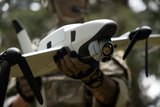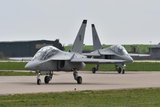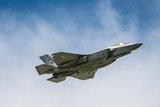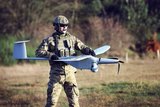Denmark to bolster maritime defences as P-8A FMS deal approved by US
The NATO country continues to focus on building up its maritime surveillance and enforcement capabilities as part of a major investment in its Arctic defences.
Miysis DIRCM system. (Photo: Leonardo)
Leonardo on 29 June announced a contract to provide its Miysis Directed Infrared Countermeasure (DIRCM) missile protection system for an unnamed Middle Eastern government’s new VVIP transport aircraft.
Miysis will be installed on a Bombardier Global 7500 aircraft (the first of its type to be selected by a government customer). The aircraft is expected to enter service in 2022.
The DIRCM system will provide ‘complete spherical protection for the aircraft and, uniquely for a system of its size, can output more than enough laser energy to protect the Global 7500 aircraft from even the most modern infrared-guided (heat-seeking) missile threats’, Leonardo noted.
The latest contract follows orders for Miysis DIRCM from the UK (for the Shadow R1 ISTAR aircraft), Canada (for the CP-140 Aurora maritime patrol aircraft) and three other NATO customers, as well as several non-NATO customers.
Miysis DIRCM works by shining a high-powered laser onto an incoming missile’s targeting system, ‘dazzling’ it and guiding the missile away from the aircraft.
Unlike competing products, Leonardo claimed, Miysis DIRCM can defend against multiple, simultaneous incoming missiles and the latest generation of shoulder-launched IR-guided MANPADS.
According to Shephard Defence Insight, Miysis can be used as a standalone DIRCM or integrated with other onboard self-protection systems.

The NATO country continues to focus on building up its maritime surveillance and enforcement capabilities as part of a major investment in its Arctic defences.

Confirming its C295 order in late December, the Spanish Ministry of Defence also awarded Airbus with its Hurjet procurement contract and both Airbus and Indra with a contract to investigate a proposed Signals Intelligence aircraft solution by 2028.

One of the key trends seen in December has been the rise in indigenous investment within the UAV market, particularly across certain countries, with Germany, Australia and the US focusing on their commitments to sovereign development.

Changing roles for combat aircraft fleets, the rise of simulation and LVC technologies, and the increasing cost of flight hours could all be leading to a paradigm shift in military pilot training.

This year’s (geo)political turmoil has challenged many long-prevailing assumptions, leading to far-reaching consequences for air forces and their supplier bases in industry worldwide – with five key trends in review for 2025.

With a rising defence budget and equipment list, Poland’s air market is set to grow as the country continues to modernise its transport and helicopter fleets while seeking out uncrewed aerial vehicles and loitering munitions.